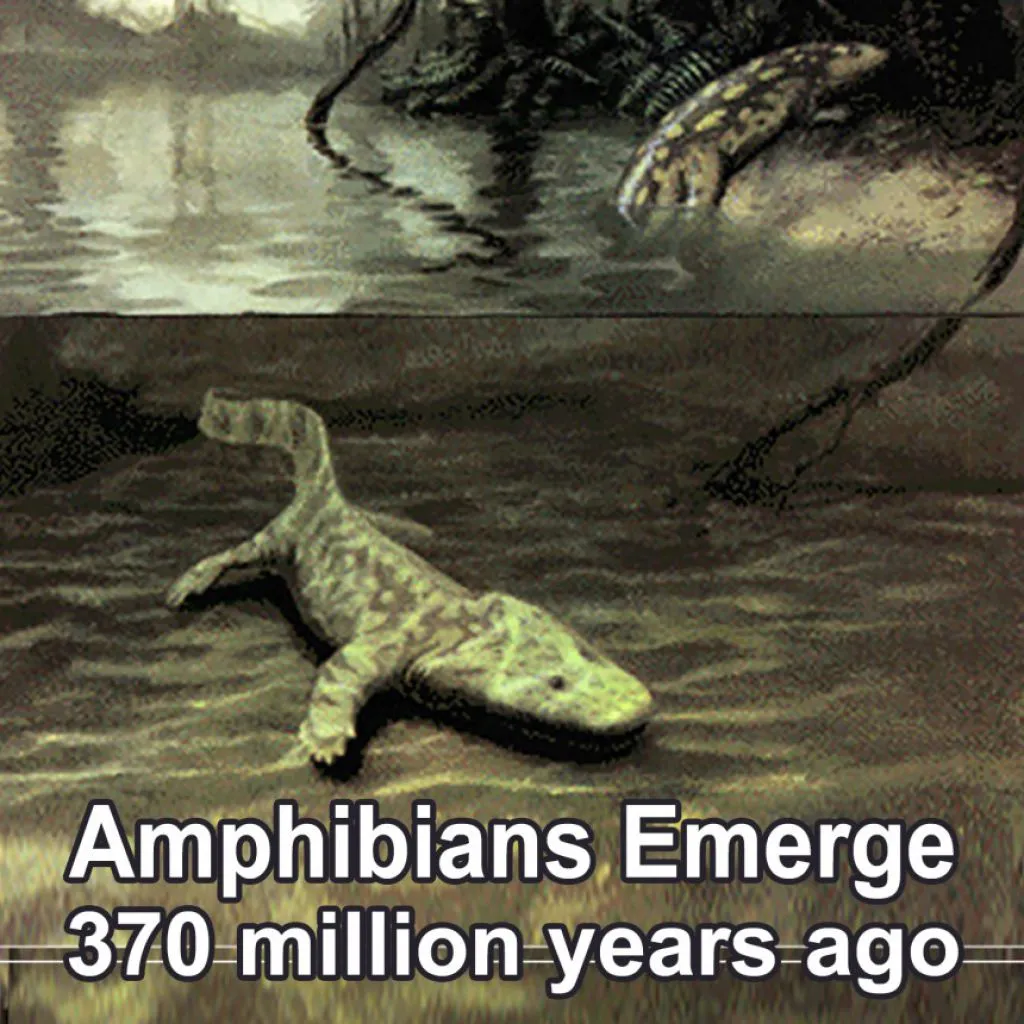
Amphibians Emerge from the water
Amphibians are ectothermic, tetrapod vertebrates of the class Amphibia.
Modern amphibians are all Lissamphibia. They inhabit a wide variety of habitats, with most species living within terrestrial, fossorial, arboreal or freshwater aquatic ecosystems. Thus amphibians typically start out as larvae living in water, but some species have developed behavioural adaptations to bypass this. The young generally undergo metamorphosis from larva with gills to an adult air-breathing form with lungs. Amphibians use their skin as a secondary respiratory surface and some small terrestrial salamanders and frogs lack lungs and rely entirely on their skin. They are superficially similar to lizards but, along with mammals and birds, reptiles are amniotes and do not require water bodies in which to breed. With their complex reproductive needs and permeable skins, amphibians are often ecological indicators; in recent decades there has been a dramatic decline in amphibian populations for many species around the globe.
The earliest amphibians evolved in the Devonian period from sarcopterygian fish with lungs and bony-limbed fins, features that were helpful in adapting to dry land. They diversified and became dominant during the Carboniferous and Permian periods, but were later displaced by reptiles and other vertebrates. Over time, amphibians shrank in size and decreased in diversity, leaving only the modern subclass Lissamphibia.
The three modern orders of amphibians are Anura (the frogs and toads), Urodela (the salamanders), and Apoda (the caecilians). The number of known amphibian species is approximately 7,000, of which nearly 90% are frogs. The smallest amphibian (and vertebrate) in the world is a frog from New Guinea (Paedophryne amauensis) with a length of just 7.7 mm (0.30 in). The largest living amphibian is the 1.8 m (5 ft 11 in) Chinese giant salamander (Andrias davidianus), but this is dwarfed by the extinct 9 m (30 ft) Prionosuchus from the middle Permian of Brazil. The study of amphibians is called batrachology, while the study of both reptiles and amphibians is called herpetology.
EVOLUTION
The first major groups of amphibians developed in the Devonian period, around 370 million years ago, from lobe-finned fish which were similar to the modern coelacanth and lungfish. These ancient lobe-finned fish had evolved multi-jointed leg-like fins with digits that enabled them to crawl along the sea bottom. Some fish had developed primitive lungs to help them breathe air when the stagnant pools of the Devonian swamps were low in oxygen. They could also use their strong fins to hoist themselves out of the water and onto dry land if circumstances so required. Eventually, their bony fins would evolve into limbs and they would become the ancestors to all tetrapods, including modern amphibians, reptiles, birds, and mammals. Despite being able to crawl on land, many of these prehistoric tetrapodomorph fish still spent most of their time in the water. They had started to develop lungs, but still breathed predominantly with gills.
Many examples of species showing transitional features have been discovered. Ichthyostega was one of the first primitive amphibians, with nostrils and more efficient lungs. It had four sturdy limbs, a neck, a tail with fins and a skull very similar to that of the lobe-finned fish, Eusthenopteron. Amphibians evolved adaptations that allowed them to stay out of the water for longer periods. Their lungs improved and their skeletons became heavier and stronger, better able to support the weight of their bodies on land. They developed "hands" and "feet" with five or more digits;[15] the skin became more capable of retaining body fluids and resisting desiccation. The fish's hyomandibula bone in the hyoid region behind the gills diminished in size and became the stapes of the amphibian ear, an adaptation necessary for hearing on dry land. An affinity between the amphibians and the teleost fish is the multi-folded structure of the teeth and the paired supra-occipital bones at the back of the head, neither of these features being found elsewhere in the animal kingdom.
DIPLOCAULUS
The Permian lepospondyl Diplocaulus was largely aquatic
At the end of the Devonian period (360 million years ago), the seas, rivers and lakes were teeming with life while the land was the realm of early plants and devoid of vertebrates, though some, such as Ichthyostega, may have sometimes hauled themselves out of the water. It is thought they may have propelled themselves with their forelimbs, dragging their hindquarters in a similar manner to that used by the elephant seal. In the early Carboniferous (360 to 345 million years ago), the climate became wet and warm. Extensive swamps developed with mosses, ferns, horsetails and calamites. Air-breathing arthropods evolved and invaded the land where they provided food for the carnivorous amphibians that began to adapt to the terrestrial environment. There were no other tetrapods on the land and the amphibians were at the top of the food chain, occupying the ecological position currently held by the crocodile. Though equipped with limbs and the ability to breathe air, most still had a long tapering body and strong tail. They were the top land predators, sometimes reaching several metres in length, preying on the large insects of the period and the many types of fish in the water. They still needed to return to water to lay their shell-less eggs, and even most modern amphibians have a fully aquatic larval stage with gills like their fish ancestors. It was the development of the amniotic egg, which prevents the developing embryo from drying out, that enabled the reptiles to reproduce on land and which led to their dominance in the period that followed.
After the Carboniferous rainforest collapse amphibian dominance gave way to reptiles,[18] and amphibians were further devastated by the Permian-Triassic extinction event. During the Triassic Period (250 to 200 million years ago), the reptiles continued to out-compete the amphibians, leading to a reduction in both the amphibians' size and their importance in the biosphere. According to the fossil record, Lissamphibia, which includes all modern amphibians and is the only surviving lineage, may have branched off from the extinct groups Temnospondyli and Lepospondyli at some period between the Late Carboniferous and the Early Triassic. The relative scarcity of fossil evidence precludes precise dating, but the most recent molecular study, based on multilocus sequence typing, suggests a Late Carboniferous/Early Permian origin for extant amphibians.
Many examples of species showing transitional features have been discovered. Ichthyostega was one of the first primitive amphibians, with nostrils and more efficient lungs. It had four sturdy limbs, a neck, a tail with fins and a skull very similar to that of the lobe-finned fish, Eusthenopteron. Amphibians evolved adaptations that allowed them to stay out of the water for longer periods. Their lungs improved and their skeletons became heavier and stronger, better able to support the weight of their bodies on land. They developed "hands" and "feet" with five or more digits, the skin became more capable of retaining body fluids and resisting desiccation. The fish's hyomandibula bone in the hyoid region behind the gills diminished in size and became the stapes of the amphibian ear, an adaptation necessary for hearing on dry land. An affinity between the amphibians and the teleost fish is the multi-folded structure of the teeth and the paired supra-occipital bones at the back of the head, neither of these features being found elsewhere in the animal kingdom.
After the Carboniferous rainforest collapse amphibian dominance gave way to reptiles and amphibians were further devastated by the Permian-Triassic extinction event. During the Triassic Period (250 to 200 million years ago), the reptiles continued to out-compete the amphibians, leading to a reduction in both the amphibians' size and their importance in the biosphere. According to the fossil record, Lissamphibia, which includes all modern amphibians and is the only surviving lineage, may have branched off from the extinct groups Temnospondyli and Lepospondyli at some period between the Late Carboniferous and the Early Triassic. The relative scarcity of fossil evidence precludes precise dating, but the most recent molecular study, based on multilocus sequence typing, suggests a Late Carboniferous/Early Permian origin for extant amphibians.















































